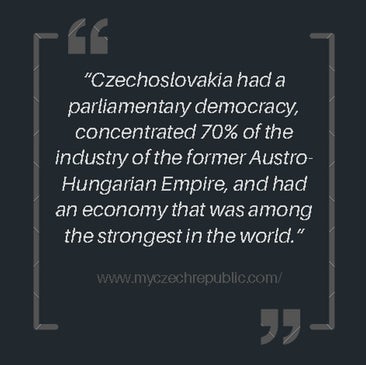Unifying the Czechs
A numerous and distinct ethnic group, the Czechs had long struggled to form their own nation – with independence and self-rule a long-standing aim.
Even prior to the First World War, there had been a large Czech nationalist movement which sought to promote this objective.
Some even wanted all Slavic people to be united, feeling that for too long, they had been oppressed by the mighty empires of Europe.
During the First World War, Czechs fought across many fronts, often for countries that had little interest in their politics – particularly in the case of Austria-Hungary.
It is unsurprising that many Czechs who found themselves fighting for this unsympathetic empire, did so with little enthusiasm, especially as they often hoped that the Austria-Hungarians would ultimately lose.
In some cases, Czech prisoners of war changed sides and fought against their former Austro-Hungarian masters.
In total, around 1.4 million Czech soldiers fought in the First World War across a range of theatres and battlegrounds with 150,000 becoming casualties. In Russia, 90,000 Czech and Slovak volunteers formed the Czechoslovak legions and fought against the Central Powers before then fighting with White Russian troops against the Bolsheviks – most notably at the Battle of Zboriv in 1917, when Russia had collapsed into Civil War. Many of these legion volunteers were deserters from Austria-Hungarian forces, where they had been forced to fight. Many were motivated to fight by wanting support for a future homeland of their own.
Czechoslavak Legion soldiers, Italian front, 1918.
Memorial to the Czechoslovaks in the battle of Zborov at Blansko, Czech Republic.
First Czechoslovak Republic
With the First World War finally coming to an end in 1918, the newly formed First Czechoslovak Republic was born from the dissolution of their former oppressors; the Austro-Hungarian empire and as part of the Treaty of Saint-Germain-en-Laye. It consisted of the former Bohemian Republic, as well as the areas of Moravia, Slovakia and Carpathian Ruthenia. It was mainly made up of areas where ethnic Slavs and Czechs were located, although significant other pockets of other ethnic groups were also present.
Czechs and Slovaks wearing Russian gas masks during the First World War.

Initially, the new country fared well with a stable government, flourishing economy and a significant number of industrialised regions. A parliamentary democracy, the republic was led by a National Assembly, made up of a Senate and Chamber of Deputies. Its responsibilities included legislative, executive and judiciary and every seven years it elected the president and confirmed the cabinet. However, the strong and capable leadership of its first president, Tomáš Masaryk (and his successor Beneš) led to the central government exerting considerable influence over local government.
The town of Karlovy Vary in the First Czech Republic, 1920.
Tomáš Masaryk
Even today, the first president of the Czech Republic, Tomáš Masaryk, is held in high regard – similar to how George Washington is revered in the United States. He succeeded in holding the country together despite facing considerable political issues and challenges.
Masaryk was re-elected three times – 1920, 1927 and 1934. Normally, a president was restricted to two consecutive terms, but such was his success, a one time provision – agreed by the 1920 constitution – allowed this to happen. Due to the republic having a complicated system of proportional representation, it was rare for any party to gain a majority of the votes – instead the total votes were frequently spread thinly across a multitude to political parties. This meant there were frequent changes to the government. During Masaryk’s time as leader, he worked with ten different governments, which helped present him as a stable, constant presence, giving him more power and influence than the constitution actually intended.
Prague, the Czech capital, in 1930.
Under Masaryk’s watch, the Czech Republic became one of the strongest democracies in Europe, and it was Masaryk himself who was one of the first to express concerns regarding the rise of Hitler in neighbouring Germany.













